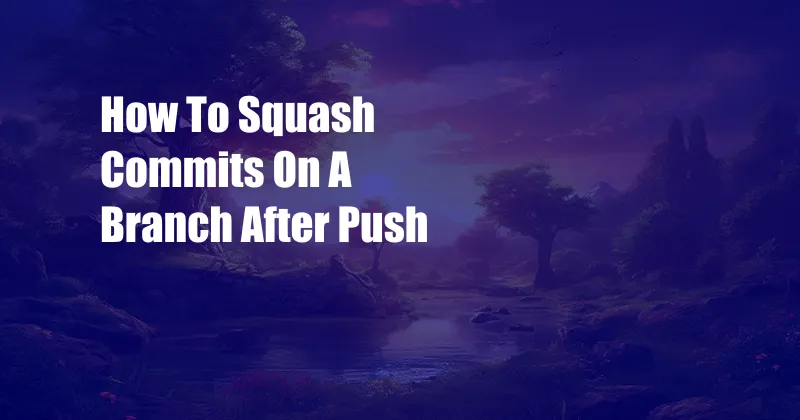
Squashing Commits on a Branch After Push
In the realm of version control, the ability to squash commits into a single, cohesive unit is a valuable skill. Squashing commits allows developers to streamline their commit history, making it easier to track changes and understand the project’s evolution. This article delves into the intricacies of squashing commits on a branch after it has been pushed to a remote repository, providing a comprehensive guide for navigating this often-complex process.
When working on a collaborative project, it’s common to make multiple commits throughout the development process. These commits may represent incremental changes, bug fixes, or even unrelated tasks. While this granular level of detail can be beneficial during active development, it can clutter the commit history and make it difficult to identify major milestones or track the project’s overall progress. Squashing commits offers a solution to this problem.
Squashing Commits and Resetting History
Squashing commits involves combining multiple commits into a single, new commit, effectively condensing the commit history. This can be particularly useful after pushing changes to a remote repository, as it allows you to reorganize and streamline your contributions without disrupting the shared history.
To begin the squashing process, you’ll need to fetch the latest changes from the remote repository using the git fetch command. Once the local repository is up-to-date, you can use the git rebase -i command to open an interactive rebase on the branch you wish to squash. This will present you with a list of commits on that branch.
Within the interactive rebase, you can select the commits you want to squash together. Typically, you’ll want to squash commits that are related to the same feature or task. To do this, change the pick command next to each commit to squash. Once you’ve selected all the commits you want to squash, save and exit the editor.
Git will then guide you through a series of prompts, allowing you to craft a new commit message that will represent the squashed commits. It’s important to provide a clear and concise message that summarizes the changes included in the squashed commit.
After creating the new commit message, git will perform the squash operation, combining the selected commits into a single commit. The original commits will be removed from the branch’s history, leaving only the squashed commit.
Tips and Expert Advice
Here are some tips and expert advice for squashing commits effectively:
- Squash commits logically: Group commits that are related to the same feature or task. Avoid squashing unrelated changes into a single commit.
- Use clear commit messages: The new commit message for the squashed commit should clearly describe the changes included. This will help other developers understand the changes made.
- Test before squashing: Before squashing commits, ensure that the changes work as intended. Squashing untested commits can lead to issues later on.
Remember, squashing commits is a powerful tool, but it should be used judiciously. Squashing too many commits can make it difficult to track changes and collaborate effectively. Aim to squash commits sparingly, focusing on reorganizing and streamlining your commit history rather than rewriting it entirely.
Frequently Asked Questions
Q: How do I squash commits on a specific branch?
A: Use the git rebase -i command to open an interactive rebase on the desired branch.
Q: Can I squash commits after pushing to a remote repository?
A: Yes, you can squash commits after pushing by fetching the latest changes and performing an interactive rebase.
Q: What happens to the original commits after squashing?
A: The original commits are removed from the branch’s history and replaced by the single, squashed commit.
Q: Is it always a good idea to squash commits?
A: While squashing commits can be beneficial in some situations, it should be used sparingly. Avoid squashing unrelated changes or commits that need to be tracked separately.
Conclusion: The Power of Squashing Commits
Squashing commits is a valuable technique that allows developers to streamline their commit history, improve readability, and enhance collaboration. By following the steps outlined in this article and adhering to the tips and advice provided, developers can effectively squash commits on a branch after push and reap the benefits of a well-organized and coherent git history.
Are you interested in learning more about squashing commits and other git best practices? I encourage you to explore the vast resources available online and engage with the developer community. With continuous learning and practice, you can master the art of git and effectively manage your version control workflow.